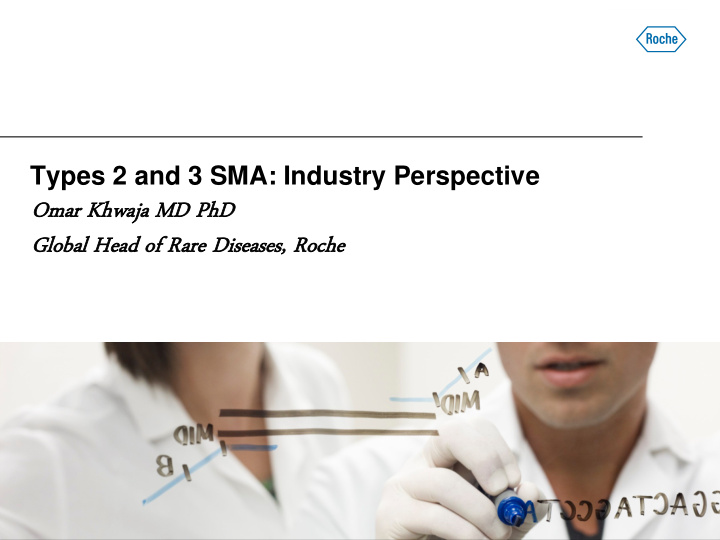



Types 2 and 3 SMA: Industry Perspective Omar K Khwa waja MD MD PhD Glo Global l Head ad o of Rar f Rare e Dis iseases, Ro Roche
Outline Patient population for inclusion in trials Control group Outcome measures Biomarkers Patient Reported Outcomes Challenges
Patient population Needs of the broad SMA patient population Heterogeneity Age and Body Size/Weight Function Disability Comorbidities
Key drivers for patient selection • Target product profile – Indication (age range and type/s of SMA) – Key claims for label • Pharmacokinetics of molecule • Route of administration/delivery • Non-clinical safety profile • Toxicology coverage • Feasibility of assessments • Comorbidities
Control group • Existence of clinical equipoise • Number of studies and rigorous design to support registration • Randomization • Configuration of randomization • Historical or non-concurrent controls • Pooling of control data • Power and sample size • Feasibility of recruitment within timelines
Outcome measures I • Selection of primary, key secondary EP, secondary EPs, exploratory EPs – Co-primary, composites, preservation of statistical power – Measurement properties – Clinical Meaningfulness and MCID • Sample size and power considerations • Duration to see effect • Applicability across – age range – ambulation status – disability – orthopedic status
Outcome measures II • Lower extremity, axial/trunk and upper extremity function – Optimum measure/s • Pulmonary function testing • Assessment of comorbidities • Disability/ability status • Integration of Real World Evidence
Biomarkers • Intended use of biomarker – Target engagement and PKPD analysis – Efficacy or surrogate endpoint – Safety • Robustness of assay (reliability, stability, reproducibility) • Fluid and tissue biomarkers (blood, CSF: mRNA, SMN protein, other) • Electrophysiological measures (CMAP, MUNE) • Digital biomarkers (sensors, wearables)
Patient Reported Outcomes • Pediatric PROs • Meet needs of range of patients • Instruments to meet Health Technology Assessors needs • Patient versus caregiver, physician or other proxy • Concept of “burden” • Robustness of evidence to support PRO • Health-related QoL, QoL • Independence, ability and disability status
Challenges • Epidemiology of Types 2-4 • Extrapolation across age, disease type and ambulatory status • Recruitment • Establishment of clinical meaningfulness • Requirement for placebo group and when does equipoise no longer exist? • Availability of robust control and natural history data • Duration of treatment • 8 month to 2 year olds • Comparator and combination studies • Pre-symptomatic patients
xt Doi oing n now ow what p patients need n d next
Recommend
More recommend